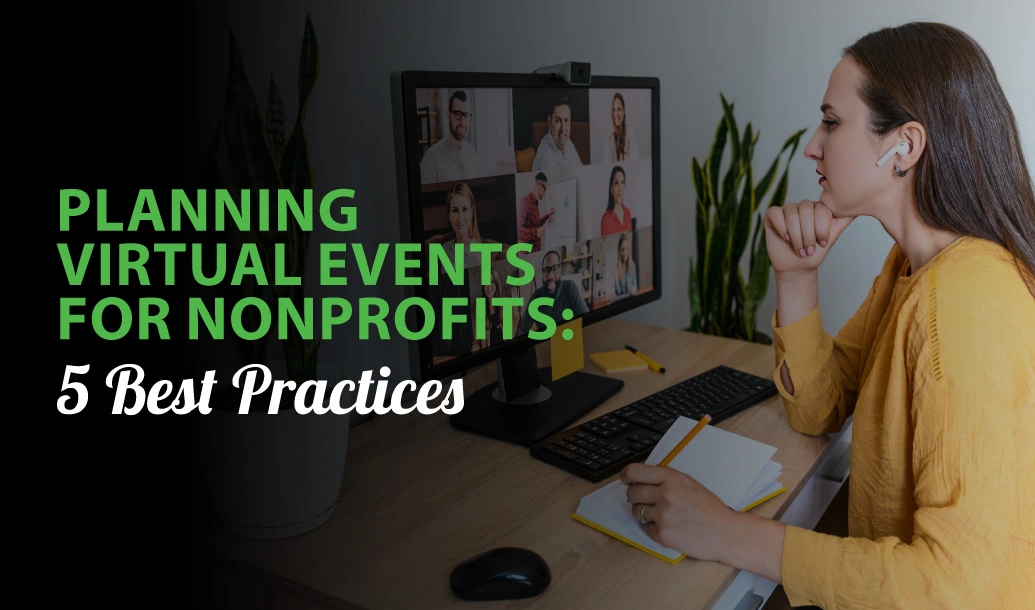Virtual events have quickly become essential for nonprofit organizations to maintain their fundraising efforts throughout the pandemic. Their convenience, flexibility, and ability to bring people together from anywhere have ensured their place in many nonprofits year-round strategy, even as we look to return to in-person events.
Despite the ease and reach of virtual events, many people still prefer the in-person alternative. According to The Giving Experience study by OneCause, 67% of attendees rated their in-person experience as excellent, whereas only 60% said the same of virtual events. Although the gap is relatively small, there are always opportunities for improvement in the execution of virtual events.
Whether this is your first time planning a virtual event or your event calendar has been packed with online fundraisers, we can provide tips to help you host the most effective virtual event from start to finish.
We’ve put together the top five best practices for planning virtual events, to drive engagement and fundraising. When planning your event, remember to:
- Start planning early.
- Use the right software.
- Create an agenda.
- Prepare interactive activities.
- Market the event.
With these best practices, you can knock your virtual events out of the park, creating a memorable experience for everyone involved. Let’s get started!
1. Start planning early.
As with any event, preparing early is the key to success. This rule could not be more true when it comes to virtual fundraising events. Logistically, virtual events can have a lot more to figure out. There’s a series of activities to maintain engagement and create success, including everything from your event format to guest registration to technology to virtual programming.
Beginning your preparations early ensures that everything goes off without a hitch when the day finally arrives. Start by hosting a brainstorming session with your event planning team to begin sorting out the details of your virtual event, such as:
- Type of event
- Fundraising goals
- Registration method
- Ideal number of attendees
- RSVP deadline
- Activities for participants
- Host or emcee
- Follow up method
The bigger the event, the earlier you should start planning. For example, if you plan to host an online auction for Giving Tuesday or to celebrate the end of the year, start planning at least 4-6 months early. This way, you have plenty of time to work through the planning, logistics, marketing, and engagement activities.
2. Use the right software.
Because virtual events rely on technology, it’s essential that you use the right software. Virtual fundraising software can make the difference between a well-run and organized event and a jumbled or confusing one. In other words, you need the right tools if you want to host a fantastic event.
When selecting software for your virtual event, look for the following features:
- Easy registration: Getting participants to register for your event can be one of the largest obstacles for nonprofits and your guests. Make sure your registration process is as convenient and easy as possible. This is the best way to prevent potential attendees from abandoning your registration process, or becoming frustrated before your virtual event starts.
- Live-streaming: Depending on the event you’re hosting, you might want the option to live-stream, so be sure that your platform has this capability. Live-streaming is a great engagement strategy, especially if you decide to host a hybrid event down the line.
- Online giving: Did you know that ease of donating is the number one motivator for social giving? Be sure that your software makes online donations as simple as possible. Go through the process yourself, so you can see, test, and streamline your supporters’ giving experience.
- Comprehensive reporting: After your event, determine what worked well and what didn’t. With comprehensive reporting, you can gather essential information about your attendees, how much you earned, and the level of engagement. This way, your future events can only improve.
These are just some of the must-have features to consider when choosing your virtual fundraising software.
Be sure to determine what you need from your software before beginning your research. Once you have your list, check out this OneCause guide on selecting the right fundraising software solution for a list of platforms that work well with virtual events to see which one best fits your needs.
3. Create an agenda.
Although an agenda might feel formal, a brief, shareable outline of your program can greatly improve organization and attendee engagement. Over time, you can use your agendas to build donor trust by consistently following through on the plans you’ve put into place.
Other reasons you should use an agenda for your virtual event include:
- Providing clear start and end times: With virtual events, attendees want to know exactly when an event will begin and when it will end. By providing an agenda of the activities throughout your event, attendees will be able to easily plan the rest of their day or evening knowing that you will stick to the schedule you sent in advance.
- Giving attendees an idea of what to expect: Your agenda is a perfect opportunity to share what attendees can expect from your event. Share your agenda on your event fundraising site and registration page so that participants can see the flow of the event right from start to finish.
- Ensure your team is on the same page: On the day of the event, it’s easy for mishaps to get in the way. A clearly defined agenda ensures that your team stays on the same page and knows what’s up next should you encounter a technical difficulty or roadblock.
An agenda can serve as an effective planning tool, giving you a checklist to follow as you put finishing touches on your event.
4. Prepare interactive activities.
One of the greatest challenges with virtual events is maintaining engagement — and it’s scientifically proven. Studies have shown that most people lose focus just 10 minutes into a virtual meeting. That’s not a lot of time to grab your participants’ attention!
However, there are strategies you can use to maintain engagement throughout your virtual event. One of the most effective strategies is incorporating interactive activities into your virtual fundraiser to help participants play an active role in the event.
The following interactive activities are easy and drive supporter engagement:
- Polls: Polls are a great way to grab your attendees’ attention at the beginning. Start with a surprising statistic or get a sense of how much your participants know about your nonprofit. If you’d rather send your poll at the end of your event, consider asking for feedback. Your participants will appreciate that you value their opinion!
- Games: Everyone loves a fun game! Include a game, such as trivia, at some point during the event to re-engage your participants. Plus, you could even offer a prize to the winner to up the stakes. For example, this online fundraising guide suggests including games and leaderboards if you’re hosting a peer-to-peer fundraising campaign leading up to an event so you can crown your top fundraisers on the day of.
- Challenges: A challenge, especially for fundraising-focused events, can jumpstart some healthy competition. Allow participants to assemble their own teams, which makes the experience more enjoyable for them while introducing new people to your nonprofit.
Interactive activities help event attendees feel like participants rather than mere bystanders. Creating hands-on opportunities for attendees also helps to make the event more memorable by giving them a personal experience to remember your cause.
However, remember that interactive activities also require detailed preparation. Be sure that you’ve completed a test run of your technology, whether you’re sending out a poll, creating a leaderboard, or recording participants completing a dance challenge.
5. Market the event.
By marketing your event, you ensure that all of that hard work doesn’t go to waste while continuing to build brand awareness. Here are our top tips for marketing your virtual event:
- Use a multi-channel approach: You want your marketing materials to reach as many people as possible, so why limit yourself to just one marketing channel? Be sure to share information about your event on social media, in email and text campaigns, and on your website.
- Send personalized invitations: A personalized invitation can go a long way to encourage a potential attendee to sign up for your event. If you’re sending paper invitations, use your supporter’s name and include a handwritten note. You could also directly call supporters to see if they’d be interested in attending.
- Maintain consistent branding: Across your marketing materials, maintain consistent branding that aligns with your organization. This way, supporters will immediately relate the event to your nonprofit, increasing the likelihood that they will attend.
Marketing is one of the most important aspects of event planning. For this reason, be sure to establish a clear marketing strategy, including when you’ll start advertising the event and which channels you plan to use. Once the time comes to begin marketing, you won’t be scrambling to throw together a strategy — you’ll be ready to hit the ground running.
Although planning an engaging virtual event might seem challenging, it doesn’t have to be. With these best practices, you can create an enjoyable and educational experience for your supporters no matter how far apart they are. Just be sure to start early and create a detailed strategy for engagement and marketing, and you’ll be set!
About the Author: Karrie Wozniak

Karrie has spent more than a decade bringing innovative technology and fundraising strategies to the nonprofit industry. As one of the first executives at OneCause, Karrie combines her 20 years of experience in marketing with her passion for helping nonprofits expand their reach, leading industry research, marketing strategy, and fundraising consulting initiatives. She is also an active speaker on donor and fundraising trends, and has been featured on Forbes.com, Philanthropy Journal, and Nonprofit Hub.



 Support Center
Support Center